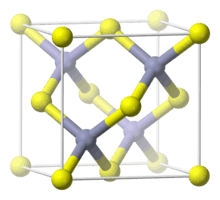Mercury selenide
Mercury selenide (HgSe) is a chemical compound of mercury and selenium. It is a grey-black crystalline solid semi-metal with a sphalerite structure. The lattice constant is 0.608 nm.
 | |
| Names | |
|---|---|
| IUPAC name
Mercury selenide | |
| Identifiers | |
CAS Number |
|
3D model (JSmol) |
|
| ECHA InfoCard | 100.039.903 |
| EC Number |
|
PubChem CID |
|
CompTox Dashboard (EPA) |
|
InChI
| |
SMILES
| |
| Properties | |
Chemical formula |
HgSe |
| Molar mass | 279.55 g/mol |
| Appearance | grey-black solid |
| Odor | odorless |
| Density | 8.266 g/cm3 |
| Melting point | 1,000 °C; 1,830 °F; 1,270 K |
Solubility in water |
insoluble |
| Structure | |
Crystal structure |
sphalerite |
| Thermochemistry | |
Heat capacity (C) |
178 J kg−1 K−1 |
Std enthalpy of formation (ΔfH⦵298) |
247 kJ/mol |
| Hazards | |
EU classification (DSD) (outdated) |
Very toxic (T+) Dangerous for the environment (N) |
| R-phrases (outdated) | R26/27/28, R33, R50/53 |
| S-phrases (outdated) | (S1/2), S13, S28, S45, S60, S61 |
| NFPA 704 (fire diamond) | 
0
3
1 |
| Flash point | Non-flammable |
| Related compounds | |
Other anions |
Mercury oxide Mercury sulfide Mercury telluride |
Other cations |
Zinc selenide Cadmium selenide |
Except where otherwise noted, data are given for materials in their standard state (at 25 °C [77 °F], 100 kPa). | |
| Infobox references | |
Mercury selenide can also refer to the following chemical compounds: HgSe2 and HgSe8. HgSe is strictly mercury(II) selenide.
HgSe occurs naturally as the mineral Tiemannite.
Along with other II-VI compounds, colloidal nanocrystals of HgSe can be formed.
Applications
- Selenium is used in filters in some steel plants to remove mercury from exhaust gases. The solid product formed is HgSe.
- HgSe can be used as an ohmic contact to wide-gap II-VI semiconductors such as zinc selenide or zinc oxide.
Toxicity
HgSe is non-toxic as long as it is not ingested due to its insolubility. Toxic hydrogen selenide fumes can be evolved on exposure to acids. HgSe is a relatively stable compound which might mean that it is less toxic than elemental mercury or many organometallic mercury compounds. Selenium's ability to complex with mercury has been proposed as a reason for the lack of mercury toxicity in deep sea fish despite high mercury levels.[1]
References
- Watanabe, C. (2002). "Modification of Mercury Toxicity by Selenium: Practical Importance?". The Tohoku Journal of Experimental Medicine. 196 (2): 71–77. doi:10.1620/tjem.196.71. PMID 12498318.
- Nelson, D.; Broerman, J.; Paxhia, E.; Whitsett, C. (1969). "Resonant Phonon Scattering in Mercury Selenide". Physical Review Letters. 22 (17): 884. Bibcode:1969PhRvL..22..884N. doi:10.1103/PhysRevLett.22.884.
- Jayaraman, A.; Klement, W.; Kennedy, G. (1963). "Melting and Polymorphic Transitions for Some Group II-VI Compounds at High Pressures". Physical Review. 130 (6): 2277. Bibcode:1963PhRv..130.2277J. doi:10.1103/PhysRev.130.2277.
- Gawlik, K. -U.; Kipp, L.; Skibowski, M.; Orłowski, N.; Manzke, R. (1997). "HgSe: Metal or Semiconductor?" (PDF). Physical Review Letters. 78 (16): 3165. Bibcode:1997PhRvL..78.3165G. doi:10.1103/PhysRevLett.78.3165..
- Kumazaki, K. (1990). "Dielectric properties of narrow-gap semiconductors". Journal of Crystal Growth. 101 (1–4): 687–690. Bibcode:1990JCrGr.101..687K. doi:10.1016/0022-0248(90)91059-Y.
- SNV (1991) Guidelines on measures and methods for heavy metal emissions control. Solna, The Swedish Environmental Protection Agency – Naturvårdsverket.